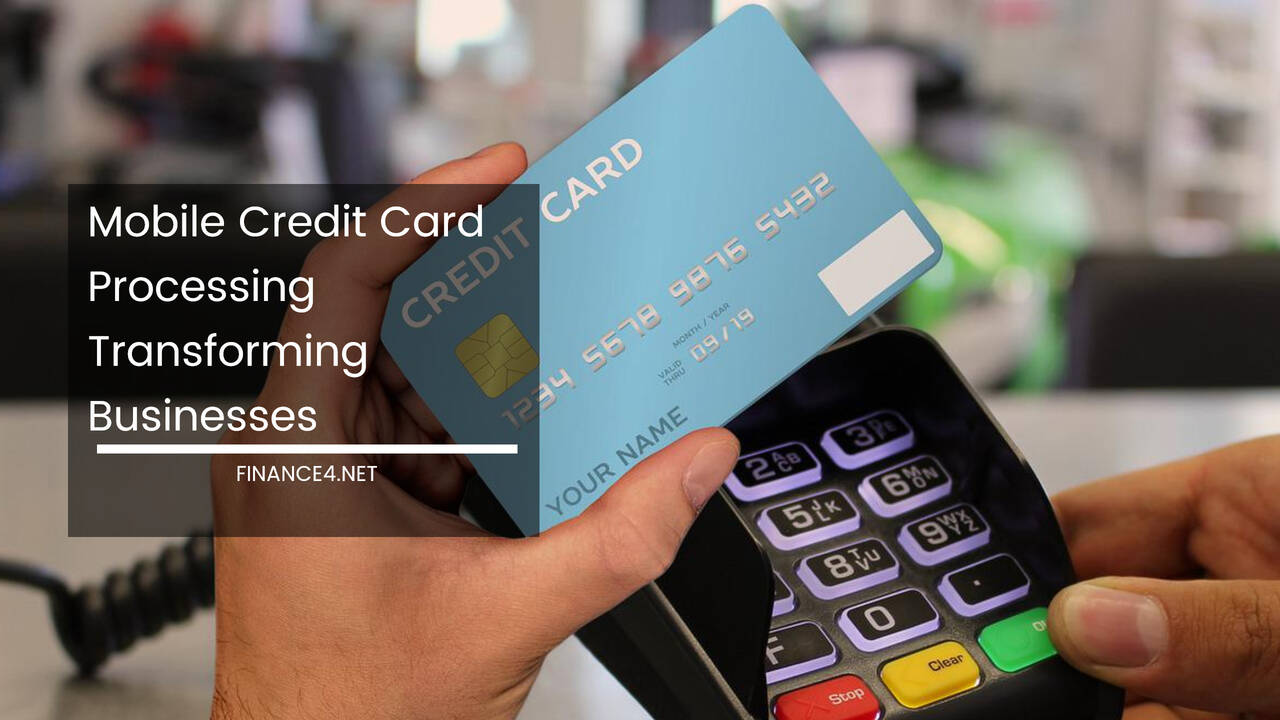Mobile Credit Card Processing Transforming Businesses

In the contemporary financial landscape, the traditional practice of carrying cash has undergone a seismic shift, with people increasingly eschewing physical currency in favor of the convenience offered by debit and credit cards. Even for the most mundane transactions, such as purchasing a cup of coffee, the reliance on plastic has become ubiquitous.
Notably, this trend has transcended the realm of individual consumers, extending its influence to entrepreneurs, trade show exhibitors, and small-business proprietors who are now leveraging mobile phones to process credit and debit card payments while on the move.
The advent of mobile payment systems has undeniably revolutionized the payment environment, ushering in a new era of convenience and efficiency. A pivotal report highlighted that mobile commerce sales in the United States, encompassing transactions made via smartphones and tablets, surged to an impressive $5.3 billion in 2011. This staggering figure marked an astounding 83 percent increase from the preceding year, foreshadowing a trajectory of continued growth in the years to come. This not only underscores the rapid adoption of mobile payment technologies but also emphasizes the need for businesses to adapt and embrace these changes to stay relevant in an increasingly digital marketplace.
As businesses navigate this dynamic landscape, it becomes imperative to identify an optimal mobile credit card processing solution that aligns seamlessly with their unique needs. Several key criteria merit careful consideration in this pursuit, ranging from pricing structures to hardware compatibility and transaction features. Let’s delve deeper into each of these aspects to provide a comprehensive understanding of the evolving landscape of mobile credit card processing.
Pricing: A Crucial Determinant
One of the foundational elements in selecting a mobile credit card processing solution is understanding and evaluating the associated pricing structures. It goes beyond the overt costs like setup fees and monthly service charges, delving into the intricacies of per-transaction fees incurred each time a credit card is processed. Within this per-transaction fee, two distinct elements come into play: the base rate and the processing rate. Both of these factors are contingent on the utilization of a payment gateway and merchant account.
The challenge lies in striking the right balance between these elements, considering the unique financial dynamics of each business. For instance, while one service might boast a low per-transaction fee, another might compensate with a high authorization rate. Calculating the average sales volume becomes crucial in identifying the most suitable combination that ensures cost-effectiveness without compromising service quality. A nuanced approach to pricing considerations empowers businesses to make informed decisions that align with their financial goals.
Hardware Compatibility: Mobilizing Transactions
Another pivotal consideration in the realm of mobile credit card processing is the availability of compatible hardware. Mobile credit card processing applications have been designed with versatility in mind, ensuring compatibility with a myriad of popular mobile phones. This adaptability extends further to encompass the option of utilizing mobile card readers or opting for Bluetooth printer/reader combos. The portability of these devices not only enhances convenience but also translates into lower swipe-transaction fees, offering businesses a cost-effective solution tailored to their mobility needs.
The symbiotic relationship between software applications and hardware solutions is integral to the seamless functioning of mobile credit card processing systems. As technology continues to evolve, ensuring that businesses stay abreast of the latest advancements in hardware compatibility becomes paramount. This proactive approach not only future-proofs the payment infrastructure but also positions businesses to leverage emerging technologies for enhanced operational efficiency.
Transaction Features: Beyond the Basics
Beyond the fundamental capability of accepting credit cards on the go, businesses stand to benefit significantly from an array of additional transaction features offered by modern mobile credit card processing solutions. These features extend beyond mere transaction processing, transforming the mobile device into a comprehensive tool for managing various aspects of the sales process.
Imagine capturing customer signatures directly on the mobile device, calculating sales tax with precision, accepting tips seamlessly, and efficiently managing customer information. These features not only streamline the transactional aspect of the business but also contribute to an enhanced customer experience. Moreover, the ability to promptly email receipts to customers adds an extra layer of convenience and professionalism.
Realizing these transaction features hinges on the compatibility of the mobile phone, network, and services employed. It underscores the importance of businesses adopting a holistic approach, ensuring that their chosen mobile credit card processing solution aligns seamlessly with their broader operational ecosystem.
Furthermore, it is noteworthy that merchant credit card processing services prioritize the security of sensitive information through the implementation of SSL encryption. This encryption ensures the confidentiality and integrity of the data, safeguarding businesses and their customers from potential security threats.
In addition to encryption measures, individual mobile applications often incorporate additional safety measures in the event of theft or loss of the device. Password protection and multifactor authentication add layers of security, ensuring that unauthorized access to sensitive information is mitigated. Importantly, the assurance that credit card details are not stored on the phone further bolsters the overall safety and integrity of mobile credit card payments.
The Safety Net of Mobile Credit Card Payments
In the context of security, it is essential to recognize the inherent safety net provided by mobile credit card payments. When customers opt for credit card transactions through their mobile phones, they gain a heightened level of control and oversight. Unlike traditional methods that involve physical cards and paper imprints, mobile credit card payments empower customers to keep a close eye on their cards throughout the transaction process.
Furthermore, the absence of paper imprints reduces the likelihood of fraudulent activities associated with physical imprints or copies of credit card information. The transaction occurs in a digital realm, where the customer can monitor and verify each step of the process. This added layer of transparency not only enhances the customer’s confidence in the transaction but also contributes to the overall safety of mobile credit card payments.
The Future of Mobile Credit Card Processing
As businesses continue to embrace the convenience and efficiency offered by mobile credit card processing, the landscape is poised for further innovation. The intersection of mobility and finance is likely to yield innovative solutions that go beyond the current capabilities of mobile payment systems. The ongoing integration of emerging technologies, such as blockchain and contactless payments, holds the potential to reshape the future of financial transactions.
Blockchain, with its decentralized and secure nature, could introduce heightened levels of transparency and security to mobile credit card processing. Additionally, the growing popularity of contactless payments, facilitated by technologies like Near Field Communication (NFC), opens avenues for faster and more seamless transactions. The convergence of these technologies could usher in a new era of frictionless and secure mobile credit card payments.
As businesses contemplate the future of mobile credit card processing, staying adaptable and receptive to emerging technologies becomes paramount. This proactive approach ensures that businesses not only meet the current demands of the market but also position themselves to capitalize on future trends. By fostering a culture of innovation and technological agility, businesses can navigate the evolving landscape of mobile payments with confidence and resilience.
Conclusion: Navigating the Digital Frontier
In conclusion, the paradigm shift towards mobile credit card processing is a testament to the evolving nature of financial transactions in today’s digital age. Businesses, whether small or large, can navigate this landscape effectively by carefully considering factors such as pricing, hardware compatibility, and transaction features when selecting a mobile credit card processing solution. The synergy between these elements forms the foundation for a robust and efficient payment infrastructure that not only meets the current needs of businesses but also positions them for future growth and innovation.
As technology continues to advance, the fusion of mobility and finance is likely to yield groundbreaking solutions that redefine the way we perceive and conduct financial transactions. From enhanced security measures to innovative transaction features, the trajectory of mobile credit card processing is characterized by continuous evolution. By embracing these changes and proactively adapting to emerging trends, businesses can
future-proof their payment systems and ensure a seamless, secure, and customer-centric approach to financial transactions.
In this dynamic landscape, businesses must remain vigilant to the ever-evolving technologies that shape the mobile credit card processing arena. As blockchain, contactless payments, and other innovations continue to gain traction, there’s a growing potential for transformative shifts in how transactions are conducted.
The emphasis on security and transparency is paramount, and businesses must stay abreast of the latest encryption standards, authentication methods, and protective measures embedded in mobile credit card processing solutions. The ongoing commitment to safeguarding sensitive information not only instills confidence in customers but also mitigates risks associated with potential security threats.
Moreover, the integration of advanced transaction features, such as capturing customer signatures, calculating taxes, and managing customer information, contributes not only to operational efficiency but also to an enriched customer experience. The ability to adapt and leverage these features can set businesses apart in a competitive marketplace, fostering customer loyalty and satisfaction.
Looking ahead, the future of mobile credit card processing is likely to witness a convergence of technologies that redefine the user experience. The synergy of mobility and finance may lead to innovations that transcend the current boundaries of convenience and security. As businesses continue to embrace this digital transformation, they position themselves not just as adopters but as pioneers in shaping the future of financial transactions.
In conclusion, the digital frontier of mobile credit card processing offers businesses an opportunity to evolve, innovate, and cater to the changing expectations of consumers. By navigating this landscape with a strategic approach, embracing emerging technologies, and prioritizing security and customer experience, businesses can position themselves at the forefront of the dynamic intersection between mobility and finance. As the journey into the digital future unfolds, businesses that proactively embrace change are poised to thrive in an era where convenience, efficiency, and security define the new standard in financial transactions.



